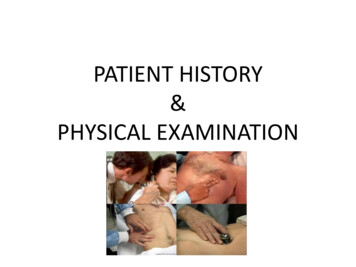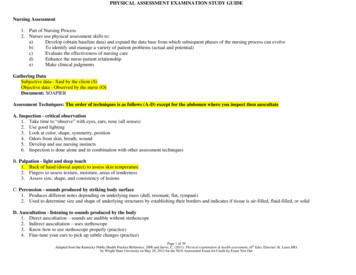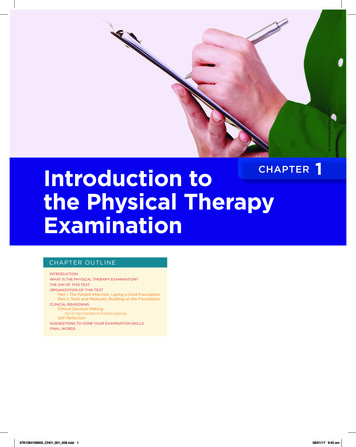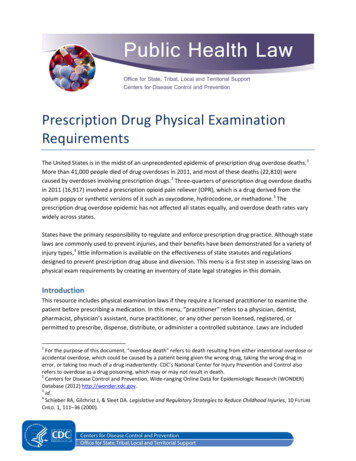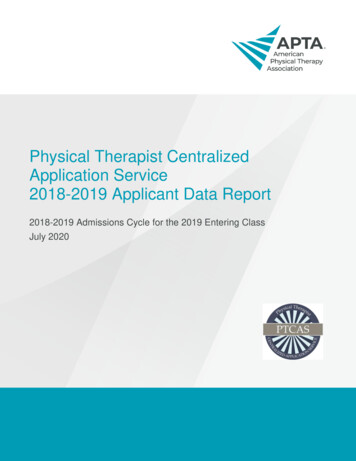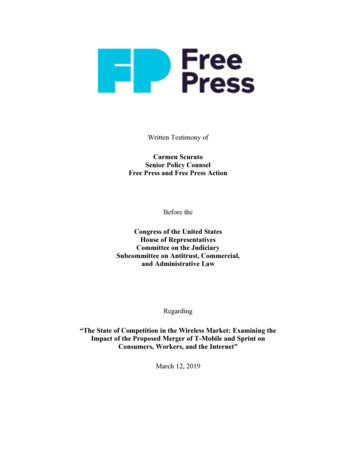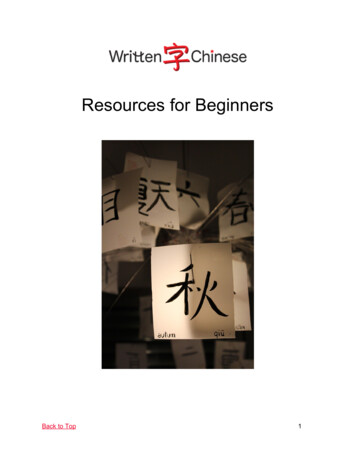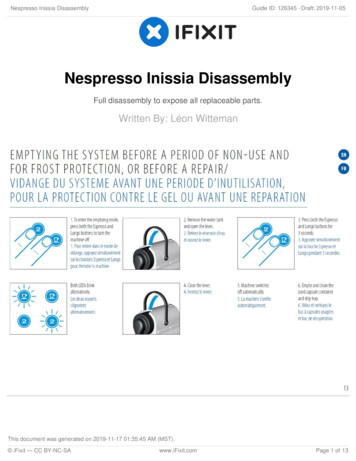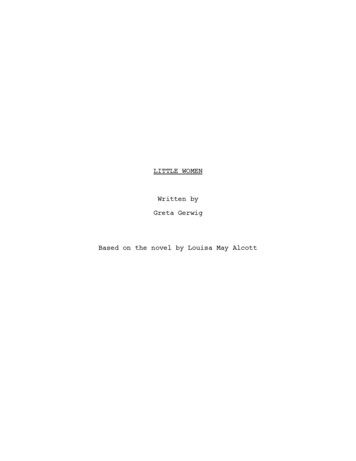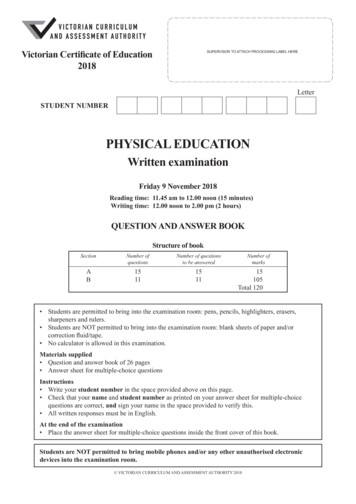
Transcription
Victorian Certificate of Education2018SUPERVISOR TO ATTACH PROCESSING LABEL HERELetterSTUDENT NUMBERPHYSICAL EDUCATIONWritten examinationFriday 9 November 2018Reading time: 11.45 am to 12.00 noon (15 minutes)Writing time: 12.00 noon to 2.00 pm (2 hours)QUESTION AND ANSWER BOOKStructure of bookSectionNumber ofquestionsNumber of questionsto be answeredAB15111511Number ofmarks15105Total 120 Students are permitted to bring into the examination room: pens, pencils, highlighters, erasers,sharpeners and rulers. Students are NOT permitted to bring into the examination room: blank sheets of paper and/orcorrection fluid/tape. No calculator is allowed in this examination.Materials supplied Question and answer book of 26 pages Answer sheet for multiple-choice questionsInstructions Write your student number in the space provided above on this page. Check that your name and student number as printed on your answer sheet for multiple-choicequestions are correct, and sign your name in the space provided to verify this. All written responses must be in English.At the end of the examination Place the answer sheet for multiple-choice questions inside the front cover of this book.Students are NOT permitted to bring mobile phones and/or any other unauthorised electronicdevices into the examination room. VICTORIAN CURRICULUM AND ASSESSMENT AUTHORITY 2018
2018 PHYSICAL EDUCATION EXAM2SECTION A – Multiple-choice questionsInstructions for Section AAnswer all questions in pencil on the answer sheet provided for multiple-choice questions.Choose the response that is correct or that best answers the question.A correct answer scores 1; an incorrect answer scores 0.Marks will not be deducted for incorrect answers.No marks will be given if more than one answer is completed for any question.Question 1Which one of the following training methods would be the best way to train for weightlifting?A. fartlekB. resistanceC. continuousD. plyometricsQuestion 2Tua, Caleb and Rocky all have a VO2 max. of 3.8 L/min.If Tua weighs 58 kg, Caleb weighs 98 kg and Rocky weighs 125 kg, who would be the most suited torunning a 10 km race?A. TuaB. CalebC. Rocky and TuaD. Caleb and TuaQuestion 3Aerobic power is theA. rate of anaerobic energy production.B. total amount of energy produced in the absence of oxygen.C. total amount of energy produced in the presence of oxygen.D. maximum rate of energy produced in the presence of oxygen.Question 4Open skillsA. are self-paced.B. allow a person to repeat the same movement pattern.C. are performed when the conditions remain unchanged.D. vary depending on the requirements of the activity or game.SECTION A – continued
32018 PHYSICAL EDUCATION EXAMQuestion 5A coach is providing crowd noises at a training session in order to simulate a game environment while anetballer is practising shooting goals.Which type of constraint is being manipulated in this scenario?A. taskB. personalC. individualD. environmentalQuestion 6Which fuel produces the least amount of energy per molecule?A. triglyceridesB. blood glucoseC. muscle glycogenD. stored ATP and PCQuestion 7During exercise, an individual’s heart rate and the force of their heart’s contractions are increased.As a result, there isA. no change in systolic blood pressure.B. a decrease in systolic blood pressure.C. an increase in systolic blood pressure.D. a large decrease in diastolic blood pressure.Question 8Which one of the following is a characteristic of an athlete in the autonomous stage of learning?A. The athlete performs subroutines out of order.B. The athlete is able to detect some of their errors on their own.C. The athlete has difficulty anticipating what movement is needed.D. The athlete can vary the accuracy, speed and uniformity of their movements.Question 9In the 2018 American football Super Bowl, Tom Brady, who was in the quarterback position, was seenquickly assessing the movement and position of his teammates and the opposition, before making a decisionabout where to pass the ball.In plays such as this, Brady would be using which type of attention?A. broad-internal focusB. broad-external focusC. narrow-internal focusD. narrow-external focusSECTION A – continuedTURN OVER
2018 PHYSICAL EDUCATION EXAM4Question 10The estimated maximum heart rate of a 50-year-old athlete would beA. 150 bpmB. 170 bpmC. 190 bpmD. 220 bpmQuestion 11Which one of the following factors affects flexibility?A. blood volumeB. body mass indexC. muscle fibre typeD. range of movement around the jointQuestion 12The coach of a local cricket team is deciding on a weekly practice schedule for the team during thecompetitive season.Day of theweekSchedule ASchedule BSchedule CSundaypractice9.00 am – 10.00 amMondayTuesdaypractice5.00 pm – 6.00 pmpractice5.00 pm – 7.00 pmpractice5.00 pm – 6.00 pmWednesdayThursdaypractice5.00 pm – 6.00 pmpractice5.00 pm – 6.30 pmpractice5.00 pm – 6.00 pmpractice5.00 pm – 7.00 pmFridaySaturdaySchedule Dpractice5.00 pm – 7.00 pmpractice5.00 pm – 6.00 pmpractice5.00 pm – 6.30 pmgame1.00 pm – 6.00 pmgame1.00 pm – 6.00 pmpractice5.00 pm – 6.00 pmgame1.00 pm – 6.00 pmgame1.00 pm – 6.00 pmWhich schedule in the table above would be considered the most massed practice schedule for the team?A. Schedule AB. Schedule BC. Schedule CD. Schedule DSECTION A – continued
52018 PHYSICAL EDUCATION EXAMUse the following information to answer Questions 13–15.In aerial skiing, the athlete skis down a relatively short hill and off a jump, and then they perform a variety oftwists and flips in the air before landing.Source: StockphotoVideo/Shutterstock.comQuestion 13Which one of the following fitness components would be the most important in aerial skiing?A. speedB. reaction timeC. aerobic powerD. muscular powerQuestion 14Which biomechanical principle is the athlete applying to their performance by spreading their arms awayfrom the torso during aerial skiing?A. accelerationB. displacementC. Newton’s first law of motionD. conservation of angular momentumQuestion 15Which one of the following psychological strategies could an aerial skier use seconds before their jump inorder to regulate feelings of stress and anxiety?A. biofeedbackB. pump-up musicC. mental imageryD. jumping aroundEND OF SECTION ATURN OVER
2018 PHYSICAL EDUCATION EXAM6SECTION BInstructions for Section BAnswer all questions in the spaces provided.Question 1 (9 marks)A coach collected data on one player during a 60-minute recreational European handball match.The data is presented in the following graph and table.Movement patterns2018161412frequency (N)1086420fast comotor categorySource: data and ideas from SCA Povos, et al., ‘Physical and Physiological Demands of Recreational TeamHandball for Adult Untrained Men’, Biomed Research International, 2017, p. 5Skill–frequency tablea.throws20jumps27changes of direction13The coach wants to assess the level of agility of his recreational European handball team.Name a suitable standardised fitness test and justify why this test is suitable, based on thephysiological requirements of the European handball team.3 marksFitness testJustificationSECTION B – Question 1 – continued
72018 PHYSICAL EDUCATION EXAMThe players undertake a plyometric training program.b.c.d.Describe two possible plyometric exercises that the coach could use as part of the plyometrictraining program.2 marksi.Identify one muscular adaptation that a European handball player would develop afterundertaking a plyometric training program.1 markii.Outline how this muscular adaptation would improve the performance of the Europeanhandball player.1 markThe overhand throw in European handball is an example of the use of a third-class lever.Explain how the mechanical advantage of a third-class lever is beneficial when throwing inEuropean handball.2 marksSECTION B – continuedTURN OVER
2018 PHYSICAL EDUCATION EXAM8Question 2 (2 marks)Ventilation is the product of tidal volume and respiratory rate.Describe the relationship between ventilation and oxygen consumption when moving from a resting state toexercising, and explain why the relationship occurs.Question 3 (11 marks)Three male subjects, all 20 years of age, participated in a three-month training program. Physiological datawas collected for each subject prior to commencing the program and at the end of the program. This data isshown in the results table below.FactorSubject 1Subject 2Subject ramPostprogramresting heart rate(bpm)605563655045maximum heartrate (predicted)(bpm)200200200200200200sub-maximal heartrate (bpm)140130160160130125stroke 12121618maximum a-vO2diff. (mL of O2/100 mL of blood)SECTION B – Question 3 – continued
92018 PHYSICAL EDUCATION EXAMSubject 1 and Subject 3 undertook the same training program for the three-month period. Subject 2participated in a different training program.a.What type of training did Subject 1 and Subject 3 most likely undertake? Justify your responseusing data from the results table on page 8.4 marksb.Explain how the changes reflected in the pre-program and post-program physiological data forSubject 1 and Subject 3 may lead to improvements in performance.3 marksc.With reference to intensity, discuss reasons why Subject 3 did not show the sameimprovement as Subject 1. Use data from the results table on page 8 to support your response. 4 marksSECTION B – continuedTURN OVER
2018 PHYSICAL EDUCATION EXAM10Question 4 (6 marks)Energy system interaction and the differences in rates of ATP turnoverduring short-term intense exercise to fatigue45403530ATP turnover(Kcals/kg/min)252015105102030405060708090 100time (s)Source: JS Baker, MC McCormick and RA Robergs,‘Interaction among skeletal muscle metabolic energy systems during intense exercise’,in Journal of Nutrition and Metabolism, vol. 2010, article ID 905612, 13 pages, 2010, p. 8, https://doi.org/10.1155/2010/905612 ; 2010 Julien S Baker, et al.Examples of track and field events in athleticsTrackField100 mshot put400 mlong jump5000 mpole vaultSECTION B – Question 4 – continued
112018 PHYSICAL EDUCATION EXAMUsing the graph and the examples of track and field events in the tables on page 10, compare thecharacteristics of the aerobic energy system and the ATP-CP energy system by discussing fuel sources,rate of ATP production and recovery.SECTION B – continuedTURN OVER
2018 PHYSICAL EDUCATION EXAM12Question 5 (13 marks)Jalena is a 17-year-old student who wants to design a training program for her upcoming lacrosseseason.a.What is the first step Jalena should complete when designing a training program for herself?b.As part of her training program, Jalena completes the following battery of fitness tests toassess her fitness levels.TestResult1 markRatingmulti-stage fitness testlevel 8 shuttle 2average35 m sprint5.29 secexcellentshoulder rotation test34 cmfairphosphate recovery test43%poorAnalyse Jalena’s results in the table above to identify the fitness components that she shouldaim to improve. Provide reasons for your answer.3 marksJalena aims to participate in long interval training twice per week and circuit training three timesper week over four weeks.c.Outline one strategy Jalena could use to monitor her training.1 markSECTION B – Question 5 – continued
13d.2018 PHYSICAL EDUCATION EXAMDesign a long interval training session that would be suitable for Jalena.2 marksMuscular endurance of both the upper and lower body is important in lacrosse.Jalena’s circuit training includes undertaking the following activities for two minutes each, with30 seconds’ rest in-between: skipping depth jumps leg swings high knees side steps sit-ups star jumps dips plank push-upse.Evaluate the effectiveness of this circuit training to improve muscular endurance for lacrosse.f.After six weeks of following her program, Jalena started to lose motivation and developedsore shins.Outline one psychological strategy that Jalena could use to stay committed to her program.3 marks1 markSECTION B – Question 5 – continuedTURN OVER
2018 PHYSICAL EDUCATION EXAMg.14Suggest a suitable nutritional strategy that Jalena could use after her training sessions andexplain how this strategy could optimise her recovery.2 marksQuestion 6 (8 marks)The size of a playing area for soccer can be manipulated using the constraints-based approach toskill coaching and instruction.a.b.Outline what type of constraint the size of a playing area is and explain how reducing the sizeof the playing area will influence opportunities to improve skills for players in the game ofsoccer.2 marksA kick in soccer could be classified as an open skill or a closed skill.Classify the soccer kick as an open skill or a closed skill and justify your response.3 marksSECTION B – Question 6 – continued
15c.2018 PHYSICAL EDUCATION EXAMThe following table presents selected physiological data collected from players in a study ofsoccer that compared activity levels during five-a-side soccer games. Players completed twogames of four minutes’ duration, with one game on each of two different field sizes. There wasthree minutes of activity recovery between games.Player averagesSmall field size(20 m 28 m)Large field size(30 m 42 m)Heart rate(% of maximum)8687Blood lactateconcentration(mmol/L)3.94.6Rating of perceivedexertion (RPE) (/10)5.96.2Source: data and methods based on E Rampinini, FM Impellizzeri, C Castagna, G Abt, et al.,‘Factors influencing physiological responses to small-sided games’,in Journal of Sports Sciences, April 2007, p. 662Using the data provided, compare the factors that cause fatigue associated with playingsmall-field and large-field soccer.3 marksSECTION B – continuedTURN OVER
2018 PHYSICAL EDUCATION EXAM16Question 7 (12 marks)Hayley and her teammates undertook a Cooper 12-minute run test as part of their local under-18football team’s pre-season battery of fi
2018 PHYSICAL EDUCATION EXAM 10 SECTION B – Question 4 – continued Question 4 (6 marks) 45 40 35 30 25 20 15 10 5 10 20 30 40 50 60 70 80 90 100 time (s) ATP turnover (Kcals/kg/min) Energy system interaction and the differences in rates of ATP turnover during short-term intense exercise to fatigue Source: JS Baker, MC McCormick and RA Robergs, ‘Interaction among skeletal muscle
